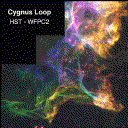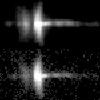Astronomy 162: Professor Barbara Ryden
Wednesday, January 22
STAR FORMATION
``Then there was a star danced, and
under that was I born.''
- William Shakespeare, Much Ado About Nothing, 2, 1
Key Concepts
- Stars form when dense clumps of interstellar gas collapse
gravitationally.
- The collapsing gas heats up and becomes a protostar.
- A protostar stops collapsing when nuclear fusion begins
in its center.
(1) Stars form when dense clumps of interstellar gas
collapse gravitationally.
Consider a small, dense dark nebula (also known
as a `Bok globule').
- M = 1 Msun
- R = 0.1 parsec = 4,400,000 Rsun
- T = 10 Kelvin = Tsun/580
The luminosity of the dense core, using the equation which relates
luminosity to radius and temperature, is:
L = 170 Lsun.
Thus, the dense core is over 100 times more luminous than the
star it is destined to become! However, since T = 10K, the
wavelength of maximum emission is:
Lambdamax = 0.29 millimeters (in the
far infrared, which is hard to detect from the Earth's surface).
To convert a dense core into a star, we must both compress it
(decreasing R by a factor of 4,400,000) and heat it (increasing T
by a factor of 580).
Dense interstellar clouds are ordinarily stable. To start
their collapse, we must first compress them with a shock wave
traveling through the interstellar medium. One source of shock
waves is supernovas (exploding stars).

Above is an image (taken with the Hubble Space Telescope) of a supernova
shock wave, in the constellation Cygnus, slamming into a molecular
cloud. The colors are computer-enhanced; the interstellar medium
isn't really as gaudy as this picture. Click on the image to see an enlarged,
higher-resolution version.
(Image credit: Jeff Hester [Arizona State University], and NASA)
(2) The collapsing gas heats up and becomes a PROTOSTAR
After the initial trigger provided by the passing shock wave,
the inward force of gravity is greater than the outward pressure force.
The gas cloud starts to collapse, and becomes a protostar.
As the center of the protostar is compressed, it heats up.
However, the protostar is initially very opaque, and the
heat at the center of the protostar takes a long time to
reach the surface. Thus, during the initial stages of the
protostar's collapse, its surface temperature T is constant,
while its radius R decreases; as a consequence, the luminosity
L decreases. Eventually, the heat from the center of the
protostar makes its way to the surface. When this happens,
the surface temperature T and the luminosity L both increase,
while the radius R remains almost constant.
The protostar is not in isolation; it is surrounded
by a rotating accretion disk in the equatorial plane, and a
bipolar outflow at its north and south poles.
The disk is important because it is capable of fragmenting into planets
(the planets around the Sun are thought to have formed in this way).
The outflow is important because it sweeps away the excess gas and
dust in the vicinity of the protostar.

Above are two images (taken 11 months apart,
using the Hubble Space Telescope) of the disk and
bipolar outflow associated with a protostar named HH30. The
outflow is aligned horizontally; the disk (which is divided in two
by a dust lane down its middle) is aligned vertically.
Click on the image
to see an enlarged higher-resolution version.
(Image credit: C. Burrows [Space Telescope Science Institute], and NASA)
Note: if the protostar is rotating too rapidly, it becomes unstable,
and breaks apart into two protostars orbiting each other. Thus,
binary systems are thought to originate from dense cores which
are rotating more rapidly.
(3) A protostar stops collapsing when nuclear fusion begins in
its center
The protostar is still collapsing inward, although far more slowly now.
It is becoming smaller and hotter. What stops it from collapsing
until it becomes a black hole?
The center of the protostar, which is becoming hotter and denser with
time, eventually reaches the point where it is so hot and so dense,
hydrogen nuclei start to fuse together to form helium nuclei.
At this point, the protostar has a fusion reactor at its center,
and is now called a star. When four H nuclei
fuse to form helium, energy is released. The energy raises the
temperature and the pressure inside the star.
We have
now reached the stable situation where the outward force of
pressure is sufficient to balance the inward force of gravity.
The star stops collapsing, and starts its sedate life as a main
sequence star, which lasts as long as the hydrogen holds out.
Protostars less massive than 0.08 Msun never become
hot enough for fusion to start; they become brown dwarfs.
Protostars more massive than 200 Msun literally
blow themselves apart before they can become stars. Such
massive protostars are very luminous.
The bright light they emit pushes on the outer layers of the
protostar (just as sunlight pushes on a comet's tail).
The outward force due to starlight is greater than the
inward force of gravity, and the star is blown away,
starting with the outer layer and working inward.
Prof. Barbara Ryden
(ryden@astronomy.ohio-state.edu)
Updated: 2003 Jan 22
Copyright © 2003, Barbara Ryden

